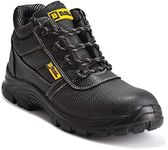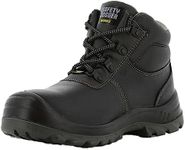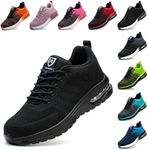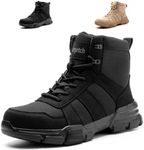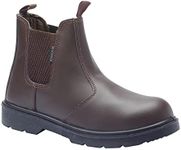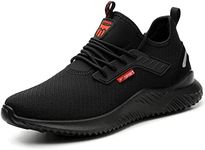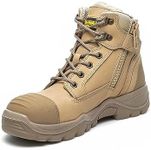Buying Guide for the Best Comfortable Safety Boot
When choosing a comfortable safety boot, it's important to consider both protection and comfort. Safety boots are essential for protecting your feet in hazardous work environments, but they should also be comfortable enough to wear for long periods. The right pair will depend on the specific hazards you face at work, as well as your personal comfort preferences. Consider the environment you'll be working in, the type of work you'll be doing, and any specific safety requirements your job may have.Safety ToeThe safety toe is a crucial feature of safety boots, designed to protect your toes from falling objects or compression. There are different types of safety toes, including steel, composite, and aluminum. Steel toes are the most traditional and offer strong protection, but they can be heavy. Composite toes are lighter and do not conduct electricity, making them suitable for electrical work. Aluminum toes are lighter than steel but still provide good protection. Choose based on the level of protection you need and the weight you are comfortable with.
MaterialThe material of the boot affects both its durability and comfort. Common materials include leather, synthetic, and rubber. Leather is durable and offers good protection, but it can be heavy and less breathable. Synthetic materials are often lighter and more breathable, making them comfortable for long wear. Rubber is waterproof and ideal for wet conditions. Consider the environment you'll be working in and choose a material that offers the right balance of protection, comfort, and durability for your needs.
Sole TypeThe sole of a safety boot is important for traction and stability. Soles can be made from rubber, polyurethane, or thermoplastic polyurethane (TPU). Rubber soles provide excellent slip resistance and are ideal for wet or oily surfaces. Polyurethane soles are lightweight and offer good shock absorption, making them comfortable for long periods. TPU soles are durable and resistant to abrasion, suitable for rough terrains. Choose a sole type that matches the conditions of your work environment to ensure safety and comfort.
Fit and ComfortFit and comfort are essential for safety boots, as you'll likely be wearing them for extended periods. A good fit prevents blisters and discomfort. Look for boots with cushioned insoles and adequate arch support. Some boots offer removable insoles, allowing you to customize the fit. Consider trying on boots at the end of the day when your feet are slightly swollen to ensure a comfortable fit. Remember, a comfortable boot will help you stay focused and productive at work.
WaterproofingWaterproofing is important if you work in wet conditions or outdoors. Waterproof boots keep your feet dry and comfortable, preventing issues like blisters and fungal infections. Look for boots with waterproof membranes or treated leather. If you don't work in wet conditions, you might prioritize breathability over waterproofing. Consider your work environment and choose a level of waterproofing that suits your needs.
InsulationInsulation is a key feature if you work in cold environments. Insulated boots help keep your feet warm, preventing discomfort and potential frostbite. Insulation is measured in grams, with higher numbers indicating more warmth. For mild cold, 200-400 grams may suffice, while extreme cold might require 600 grams or more. If you work in warm conditions, you might prefer non-insulated boots to avoid overheating. Choose insulation based on the temperature conditions of your work environment.

